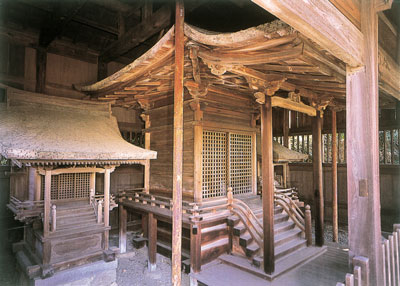本文
Banjindō (the hall of the Sanjūbanjin) of Honrenji temple
Banjindō (the hall of the Sanjūbanjin) of Honrenji temple

(From left to right) The West Shrine, Centre Shrine and East Shrine.
Nationally Designated Important Cultural Property (designated 1958)
Made: East Shrine (Ōnin 2, 1468) - Centre Shrine (ca. Meiō era, 1492-1501) - West Shrine (Meiō 9, 1500)
Location: Honrenji temple, Ushimado, Ushimado
Dimensions: Center Shrine width: 1.52m
The Banjindō is dedicated to the Sanjūbanjin, which are a group of thirty gods in Japanese syncretic Shinto-Buddhism said to protect people throughout the month. It comprises a row of 3 shrines, each, according to inscriptions, added at different times; the east shrine was built in 1468, and the west shrine in 1500. As the centre shrine lacks an inscription, it has been estimated based on typology to have been built at some point between 1492-1501.
While the East Shrine is overall the most finely balanced in its appearance, all the shrines are well-preserved, making this cultural property an important example of the architectural style employed in small shrines of the Muromachi period (14th-16th c. CE).
The wooden shelter which protects the shrines was made later in the early 18th century, and is therefore not included in the building’s cultural designation.





